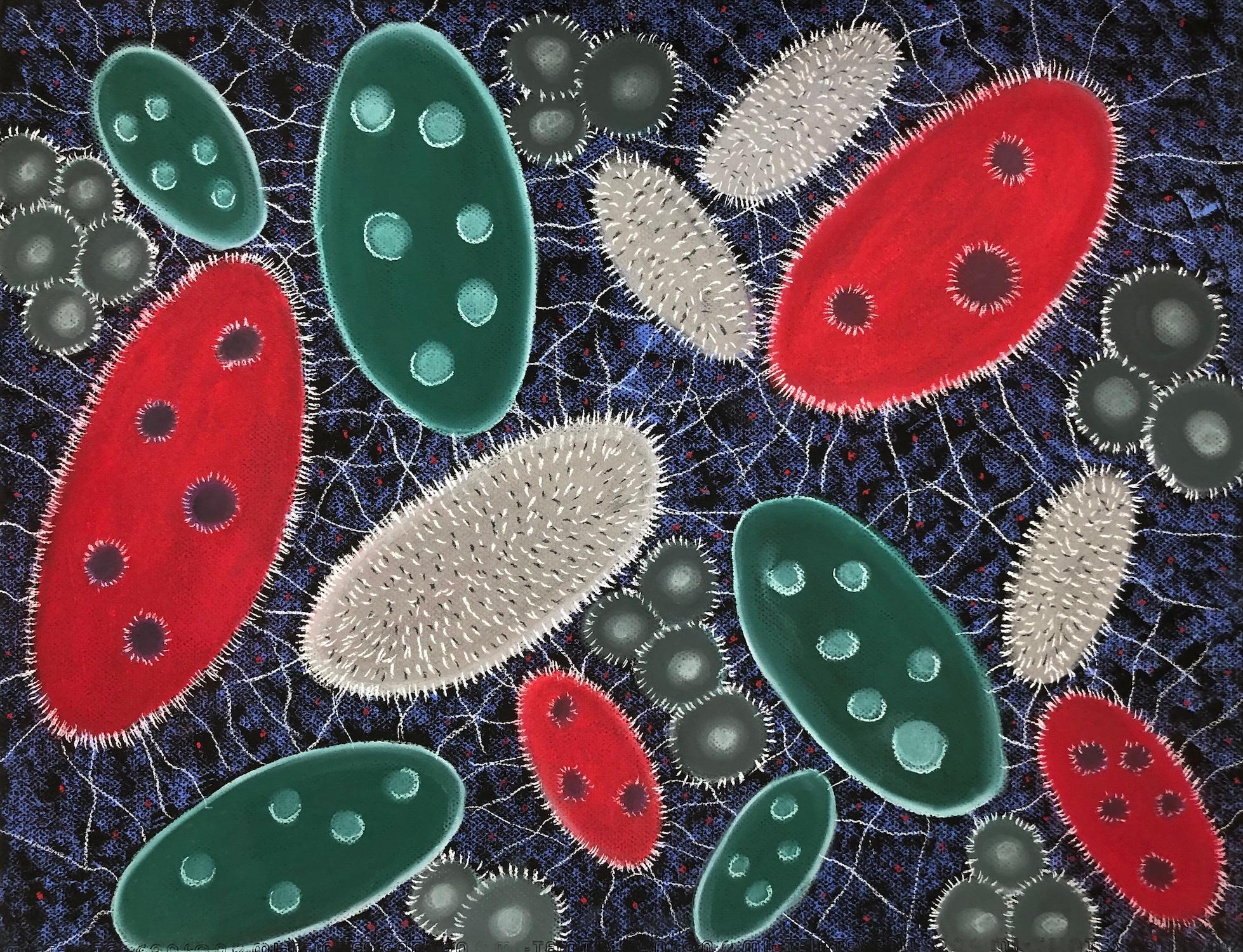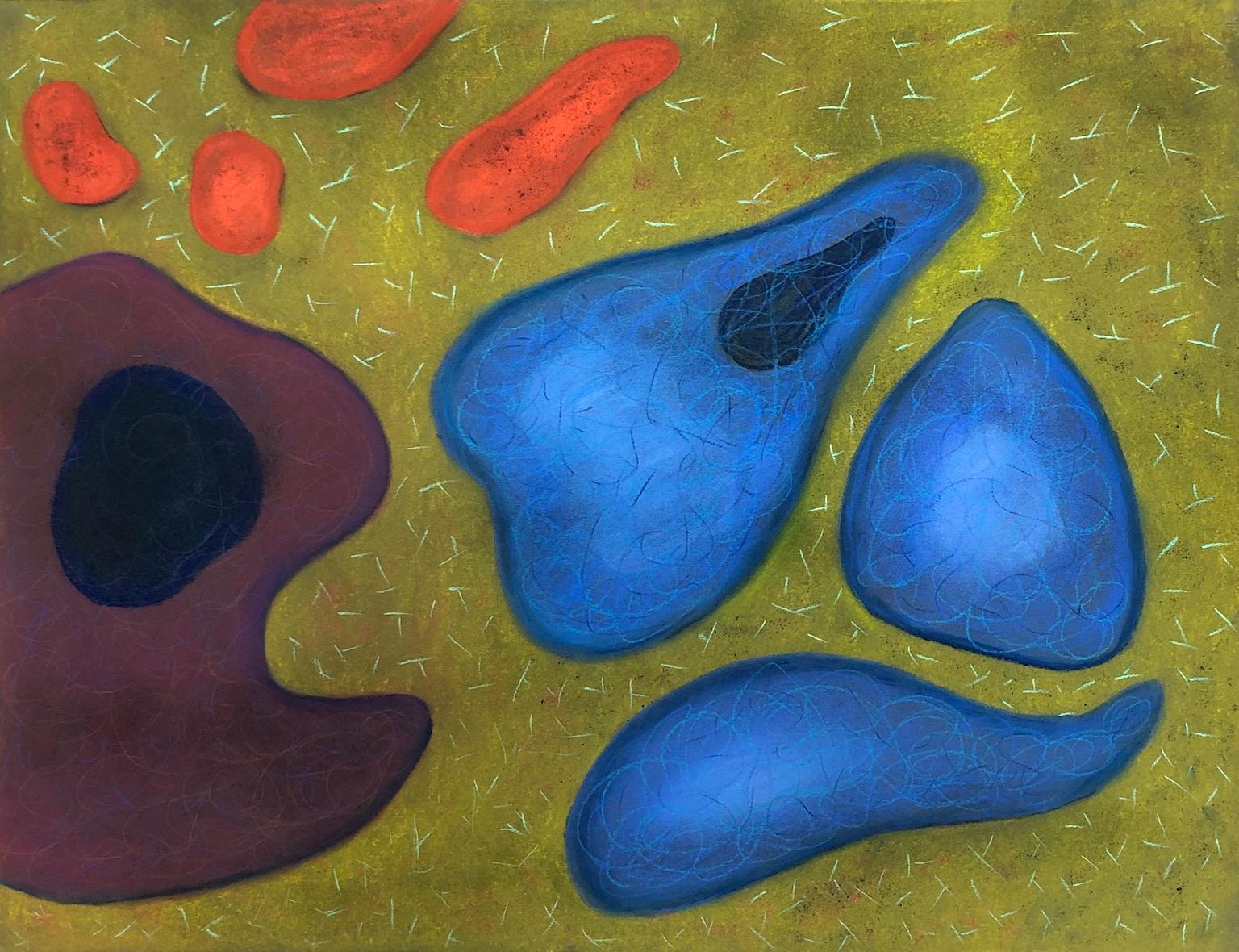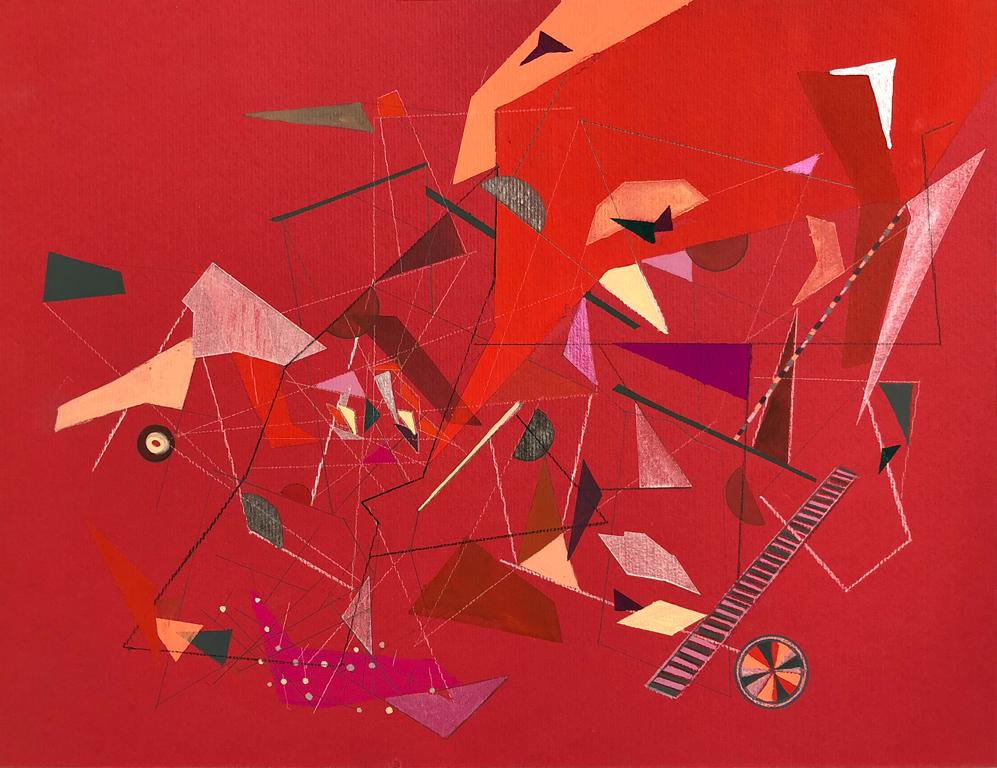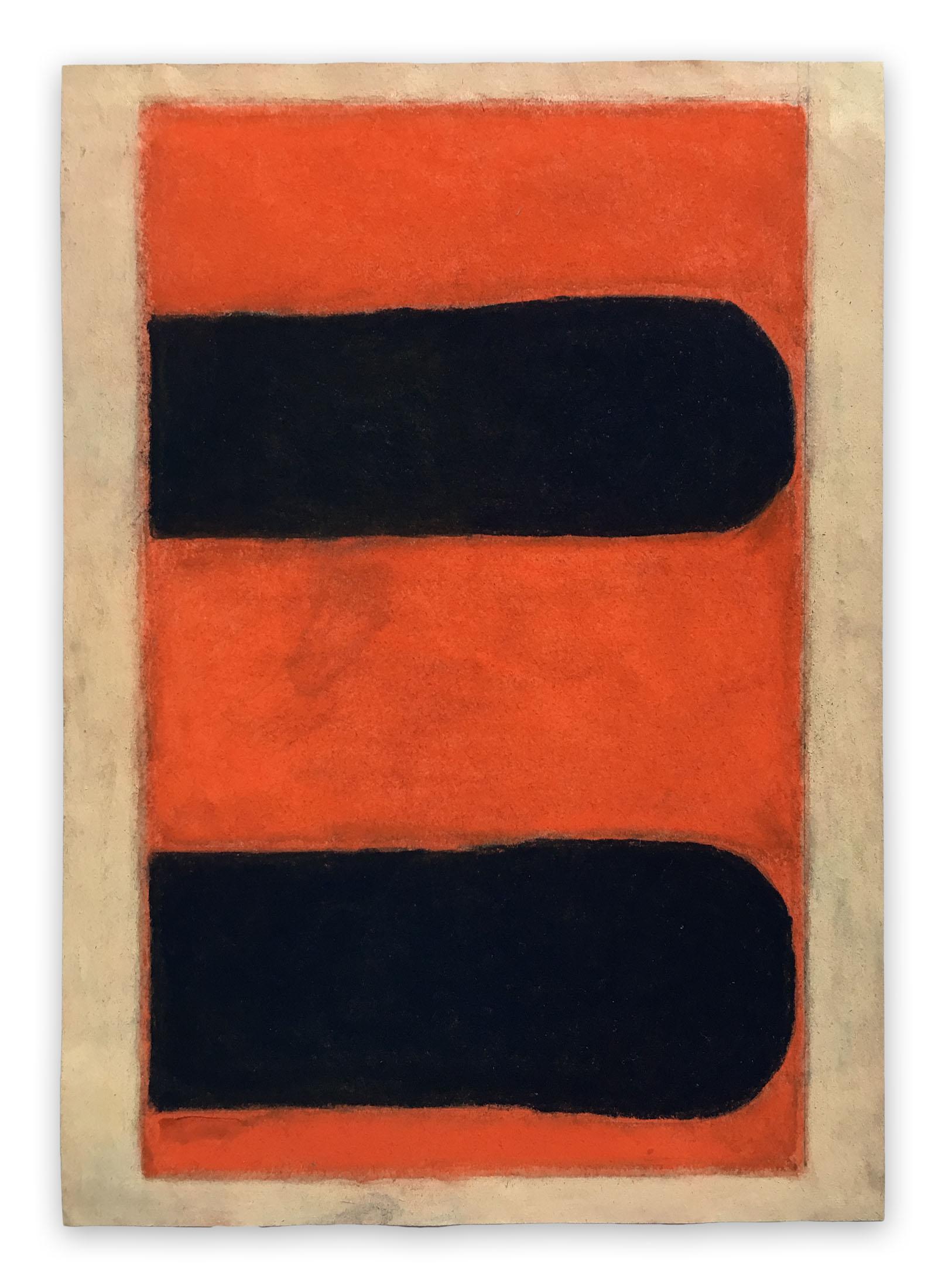Items Similar to Fauvist Pastel by Iranian American modernist Simon Samsonian
Want more images or videos?
Request additional images or videos from the seller
1 of 9
Simon SamsonianFauvist Pastel by Iranian American modernist Simon Samsonian 1991
1991
About the Item
Simon Samsonian (1912-2003)
Untitled, 1991
Poster color and pastel on paper
Sight size: 19 1/2 x 14 3/4 in.
Framed: 28 1/4 x 22 1/4 in.
Signed lower left: Samsonian 1991
Inscribed lower left: "Untitled" 1991 (Poster Color & Pastel)
Simon Samsonian was born in Samson, a small seashore town and seaport in North Turkey, the province of Trabizon. In 1915 it had a population of around 15 000, from which around one third were Armenians. The rest were Greeks and Turks.
We don’t know the precise birth date of Simon because later on he only remembered vaguely that at the beginning of the great genocide of the Armenians in Ottoman Turkey, in mid 1915, he was a 2-3 years old small child. So, we can only surmise that he was born during 1912-13. During the genocide most of the Armenian population perished, including of course Simon’s parents and relatives. However, he was fortunate to be rescued by a few years older sister named Hasmig, who ran away carrying him with her. Hasmig soon delivered her small brother to a line of children rescued by Greek nuns, but owing to the chaotic situation she disappeared from his life.
The nuns kept the small orphans with them for a few years, in a local orphanage, and when Greek troops occupied Izmir on May 15, 1919, they moved to that coastal city which was considered at the time to be a safer place to live. There Greek nuns in an orphanage who kept Simon with other children, named him Samsonian, after the town of Samson where he was born.
On September 9, 1922, Turkish republican troops invaded Izmir and in a few days put the Greek and Armenians quarters to fire. Now, ten years old Simon once again alongside other thousands, found temporary refuge in Constantinople (Istanbul), but within a year (on October 6, 1923) this city also fell to the Turks. This time the orphans were whisked away by American warships to a temporary orphanage site on the beautiful Greek island of Syra, found by the American Committee for Relief in the Near East, ACRNE (known as NER and created in 1918).
From October 1923 to August 1928, he at last enjoyed a peaceful childhood on the land of Hellas. Those were undoubtfully the most memorable days of his early life.
The second phase of Samsonian’s life began when he was transported to Egypt, and along with 32 other orphans temporarily lived on the top floor of Kalousdian Armenian National School at Boulaq, Cairo.
From 1932-1936 he studied art at the local Leonardo Da Vinci School, under the financial sponsorship of Kalousdian Alumni Association.
His first one-man show was held in 1936 at the Armenian Artistic Club, Cairo. Then he found a job in an Armenian printing house, meanwhile he became art teacher in Kalousdian Armenian National School (1936-1939). In 1939 he married to Lucy Guendimian, one of his students in Kalousdian. At once she became his lifelong friend and a best mother for their three children.
Beginning from 1937, Samsonian participated regularly in the annual saloons of Cairo. In 1945 he participated by 7 works in the first great exhibition of Armeno-Egyptian artists held in Cairo during March 25 April 15, at the Oriental Company of Publicity.
In the first half of March 1949 he exhibited 90 of his works at a gallery named Egypt-Europe. Critic Dikran Antranikian praised this exhibition, however speaking of some crudity in several works.
But the most important “event” in Samsonian’s artistic life occurred during the 1st half of 1950, when he visited Europe (Italy, Paris and London) to study the great artistic heritage of Western Europe. This journey changed his aesthetical conceptions drastically. However, he never fell under the direct influence of European great masters, (either classical or modern) and constantly guarded the originality of his art. Once back in Cairo, his Stylized Realism involved gradually to include elements of Fauvism and Cubism.
The years 1950-1968 are the most “brilliant” years in the life and artistic carrier of Samsonian. After around four “transitive” years (1950-1954), in 1955 an excellent work like the Portrait of Lucy, his wife, marks the beginning of his new style, which was more original and robust.
Now he was in the flower of his professional excellence, and starting from then on, he created a series of excellent works like Fellaha (Egyptian country girl, 1956), the Cello Player (exhibited in the second Biennale of Alexandria in 1957), The Resting Ballerina (1957), Young Girl at the Beach (1958), The Caliph Omar Ibn al- Khattab Praying in Jerusalem (1960). This last work was highly praised by both the public and artistic circles and is considered today one of the most important works in the modern Egyptian art. The Blind Man (1961), Reading at the Beach (1962), Rest (1963), The Student (1964), Tenderness (1967) etc.
In this period he regularly participated in many group exhibitions in Cairo and Alexandria. Like most annual saloons of Cairo, the first three Biennales of Alexandria (1955, 1957, 1959). The four group exhibitions of Armeno-Egyptian artists held in Cairo (1945, 1958, 1962) and Alexandria (1953) etc.
However, “the crown” of Samsonian’s artistic activities in Egypt was his third solo exhibition held in Cairo, at the galleries of the Society of the Friends of Art (Societe des Amies de l’Art). This exhibition was held during 11 to 22 January, 1961.
Samsonian exhibited 41 paintings created during the last decade. Critic Jean Moscatelli highly praised this exhibition in an article published in Le Progres Egyptien (14 January 1961). He mentioned specifically the well-balanced and strong compositions of Samsonian’s works.
In the spring of 1964, the artist’s painting titled The Student, won the first prize in the Salloon of Cairo. As a reward he was sent on a paid journey to Europe by the Egyptian Ministry of Culture. He visited (for the second time in his life) Paris and London, studying the latest innovations in plastic arts in 1965 and 1967. Thus, Samsonian became the most celebrated Armeno-Egyptian artist in the history of the twentieth century art of Egypt.
In 1965 and 1967 he also won the first prize in the Saloons of Cairo. Thus, he became the most celebrated Armeno-Egyptian artist (excepting Ashod Zoryan) in the history of the 20th century Egyptian art.
1968 was a crucial year for Simon Samsonian. In this year, in order to join his son Hagop and elder daughter Sona who had migrated to America few years earlier, he also left Egypt with his wife and younger daughter Hilda and moved to New York.
On their way to USA they stayed 2 months, May and June, in Athens. In the first half of June, Samsonian held in Athens, a solo exhibition of his works, exhibiting 14 oil paintings and 24 water colours, sponsored by Australian Qantas airways.
This was his fourth private exhibition, which was highly praised by the Greek media, including Ethnos, the largest newspaper, and a critic named Panaiotopoulos considered this exhibition “the best cultural event of the year”.
After many years we can consider this exhibition as a spontaneous act of gratitude to the country which hosted Samsonian (and around 20 000 orphans from both sexes) more than 40 years ago.
In New York, where his children had established previously, he abruptly found himself in a totally different social and cultural environment. However, being enthusiastic he was highly active during the early phase in America.
In his 1st year in New York (1968), his solo exhibition was held in the gallery of the Armenian Benevolent Union. It was natural that he exhibited only works created in Egypt. In 1969, his second solo exhibition was held in the Canadian city Toronto, at KAR galleries. Then in January 1972 a third solo exhibition was held in the Lynn Kottler galleries in Madison Avenue New York. Also in the same year the Art Committee of the City University of New York organized his 4th private exhibition in the new world.
In 1973, his “greatest dream” was realized. He visited Armenia (for the first and last time) accompanied by his wife, and held in the capital Yerevan, a retrospective exhibition of his works.
In 1988, the Armenian General Benevolent Union published in New York an album presenting his life and art. However, since then on he gradually lost interest in promoting his art in New York galleries, and lived a quiet life, being satisfied by creating works of art from time to time, till his death which occurred in November 4 2003.
Samsonian lived around ninety years. His life was full of dramatic events and joyful achievements, especially during his second life period in Egypt. But in USA after around a decade of a highly productive phase when he had already created some of his best works, like in the Subway (1970), The Girl in the Balcony (1971), Mother and Child (1973), Lady with Guitar (1974), and some beautiful still life-s, his art began to lose its usual strength of composition and depth of expression, and his paintings tended to become “flat” and decorative.
This was probably because of being disappointed and frustrated in America, when he found his artistic preconceptions quite alien to the dominant artistic trends there, where such non-figurative artists like De Kooning and Pollock were highly praised.
A posthumous exhibition of Samsonian’s works was held by the Armenian Museum of America (AMA) in New England, during September 29 until November 8, 2013, under the subtitle A Master Rediscovered, at Adelle and Haig Der-Manuelian Gallery.
Bio sourced from Armenian General Benevolent Union Egypt
- Creator:Simon Samsonian (1912 - 2003)
- Creation Year:1991
- Dimensions:Height: 19.5 in (49.53 cm)Width: 14.75 in (37.47 cm)
- Medium:
- Movement & Style:
- Period:
- Condition:
- Gallery Location:Larchmont, NY
- Reference Number:1stDibs: LU2211211527522
About the Seller
5.0
Platinum Seller
These expertly vetted sellers are 1stDibs' most experienced sellers and are rated highest by our customers.
1stDibs seller since 2022
44 sales on 1stDibs
Typical response time: 1 hour
- ShippingRetrieving quote...Ships From: Larchmont, NY
- Return PolicyA return for this item may be initiated within 14 days of delivery.
More From This SellerView All
- Abstracted Nude Figure Drawing, Signed ShapiroLocated in Larchmont, NYUntitled, c. 20th Century Acrylic on paper 20 x 16 1/4 in. Matte: 24 x 20 in. Signed center: ShapiroCategory
20th Century Abstract Geometric Abstract Drawings and Watercolors
MaterialsAcrylic, Laid Paper
- Surrealist Abstract Watercolor by Mexican Artist Leonardo NiermanBy Leonardo NiermanLocated in Larchmont, NYLeonardo Nierman (Mexican, b. 1932) Springtime, 20th century Watercolor on paper 12 x 18 in. Framed: 19 1/2 x 25 1/3 in. Signed lower left: NIERMAN Provenance: Collection of Harry Glass, Long Island A leader in modern Mexican art...Category
Mid-20th Century Abstract Abstract Drawings and Watercolors
MaterialsPaper, Watercolor
- Lovely Watercolor Panels by Japanese Woman Artist Eiko KahnLocated in Larchmont, NYEiko Taniguchi Kahn (b. 1929) Untitled, c. 1960s Watercolor on board Each panel: 33 x 11 in. Framed: 45 1/2 x 32 x 1 in. Each panel signed bottom These stunning watercolor panels are beautifully mounted in a period frame. The frame needs some minor restoration but this would be a worthy repair, as it matches the artwork so nicely. Eiko Taniguchi Kahn was Japanese Artist who was born on January 24, 1929 in Fukuoka, Kyushu, Japan, to Tosuke Yamashita and Masano Taniguchi. She came to the United States in 1955, and was naturalized in 1958. She was the recipient of the President's award at the National Arts...Category
1960s Abstract Impressionist Abstract Drawings and Watercolors
MaterialsWatercolor, Board
- 1960s Illegibly signed surrealist ink drawingLocated in Larchmont, NYUnknown Artist Untitled, c. 1960s Ink on paper Sight size: 10 x 7 in. Framed: 15 1/4 x 12 1/4 in. Signed illegibly lower right: Jack Bl...?Category
1960s Surrealist Abstract Drawings and Watercolors
MaterialsPaper, Ink
- Geometric Watercolor by David Novros, California SchoolLocated in Larchmont, NYDavid Novros (American, b. 1941) Untitled (Home Savings Study), 1986 Watercolor on paper Framed: 35 1/4 x 86 3/4 x 1 3/4 in. Each panel: 30 x 42 in. From Los Angeles and working fro...Category
1980s Minimalist Abstract Drawings and Watercolors
MaterialsPaper, Watercolor
- Mary Frank Original Charcoal and Pastel 1984 Figure DrawingBy Mary FrankLocated in Larchmont, NYMary Frank (British/American, b. 1933) Chant, 1984 Charcoal and pastel on paper 41 3/4 x 29 3/4 in. Framed: 46 1/2 x 34 1/4x 2 in. Signed and dated lower right: Mary Frank 84 Midtown Payson Galleries Label Verso Mary Frank is known for creating stoneware sculptures that have the appearance of terra cotta fragments dug up at an archaeological site. Sometimes a half-finished relief head...Category
1980s Modern Nude Drawings and Watercolors
MaterialsPaper, Charcoal, Pastel
You May Also Like
- "Macroaction 13", microscopic, blue, red, green, grey, white, pastel, drawingBy Kay HartungLocated in Natick, MAKay Hartung’s “Macroaction 13” is a 19.5 x 25 inch pastel drawing done on black Canson Mi Teintes paper. In blues, red, green, grey and white this drawing is beautifully detailed wit...Category
Early 2000s Abstract Abstract Paintings
MaterialsPaper, Pastel
- "Macrovision 8", abstract, microscopic, landscape, blue, green, red, pastelBy Kay HartungLocated in Natick, MAKay Hartung’s “Macrovision 8” is a 19.5 x 25 inch pastel abstract drawing done on black Canson Mi Teintes paper. In blue, orange and red on a background of greenish yellow, the shape...Category
Early 2000s Abstract Abstract Paintings
MaterialsPaper, Pastel
- Modern Geometric Abstract in Primary Colors with Pink, Vintage Pastel DrawingBy Henry ElinsonLocated in Soquel, CAA striking modern abstract pastel on paper by listed Monterey, California artist Henry Elinson (American, 1935-2010), 1980. Featuring clean lines and bold geometric shapes in a palet...Category
1980s Abstract Geometric Abstract Drawings and Watercolors
MaterialsPaper, Pastel
- Untitled Floral Still LifeLocated in Wilton Manors, FLBeautiful floral still life by American artist Jane Piper (1916-1991) . Pastel, oil crayon and pencil on tracing paper. Image measuring 13 x 15.5 inches in ...Category
1980s Abstract Still-life Drawings and Watercolors
MaterialsParchment Paper, Crayon, Pastel, Pencil
- UntitledBy Dannielle TegederLocated in New York, NYGouache, colored pencil, graphite, and pastel on paper Signed and dated in black ink, verso This artwork is offered by ClampArt, located in New York City. Born in Peekskill, New Yo...Category
2010s Abstract Geometric Abstract Drawings and Watercolors
MaterialsPaper, Pastel, Gouache, Color Pencil, Graphite
- Untitled 1915 (Abstract Drawing)By Fieroza DoorsenLocated in London, GBUntitled 1915 (Abstract Drawing) Pastel on paper - Unframed. In her abstract drawings, collages and paintings, Fieroza Doorsen brings to life the tensions and harmonies that emerge...Category
2010s Abstract Abstract Drawings and Watercolors
MaterialsPaper, Pastel





